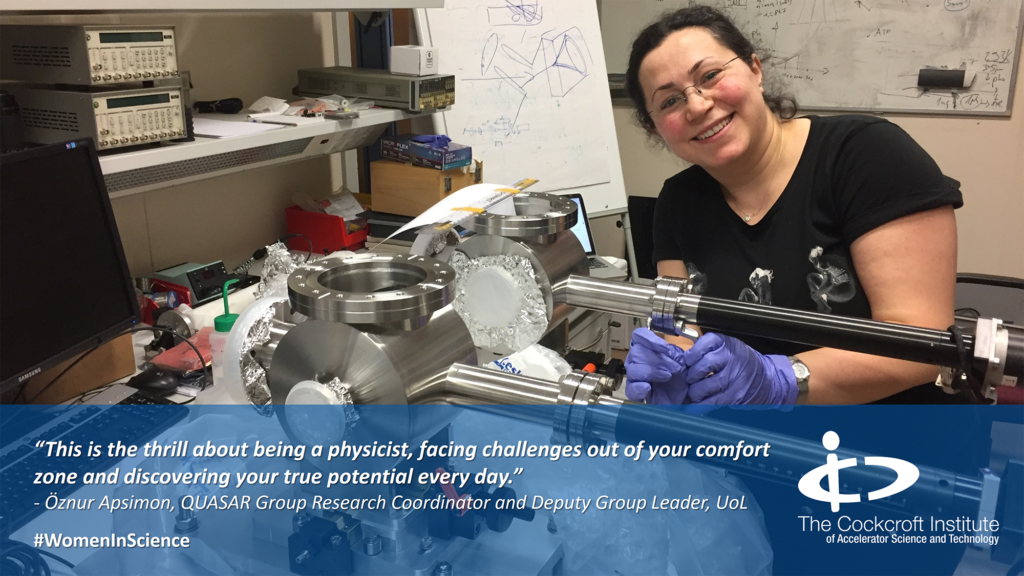
Dr Apsimon is specialised in relativistic beam dynamics interfacing novel and conventional accelerator technologies.
She studied Physics Engineering in Hacettepe University (Turkey) followed by an MSc in accelerator physics. She also took part in the Compact Linear Collider (CLIC) project at CERN. Öznur gained her MSc degree after these initial engagements with the field of accelerator physics and technology. Then, she continued her activities at CERN as a member of the CLIC project and obtained her PhD degree with with École polytechnique fédérale de Lausanne, in 2011. Her engagement with CERN continued as a research fellow until 2013..
“I decided to be a physicist after starting the science module in secondary school. It was a combination of chemistry, biology and physics and I still remember one of the first things we learned was Kirchhoff’s circuit laws that was so much fun! At that time, one of the pivotal moments was reading “Time for the Stars” from Alan Lightman alongside with many popular physics books. Being a physicist defines my vision and perspective in life beyond merely being in my job title. Day to day life is a convoluted maze of question marks that I explore one by one to make my way through. This is the thrill about being a physicist, facing challenges out of your comfort zone and discovering your true potential every day.”
In 2013, Dr Apsimon joined the Cockcroft Institute of Accelerator Science and Technology to work on CERN’s unique, proton driven plasma wakefield accelerator project AWAKE. Within the frame of the institute, she was a postdoctoral research associate in the University of Manchester and Lancaster University between 2013-2020 working on a range of topics including external electron injection and emittance diagnostics for AWAKE – a task which was lead by her, exploitation of local facility CLARA for electron driven plasma wakefield acceleration and beam physics aspects of terahertz acceleration. During this time, she specialised on beam physics under RF fields especially for space charge dominated electron beams – and emittance diagnostics in this regime -, beam physics for novel, plasma and THz based accelerators.
She joined the QUASAR Group, in the University of Liverpool, in September 2020 as a research coordinator involved in a range of projects regarding AWAKE, betatron radiation generation from under-dense plasma, non-linear optical couplings and their corrections in HL-LHC, dielectric laser acceleration and acceleration in carbon nanotubes.
“Accelerator physics/science research area is multi-disciplinary. People with backgrounds in physics and engineering can contribute to the research and development in this field.
I am currently working on the next generation accelerators made out of plasmas using high power lasers! Soon I will be building my own prototype in our lab which excites me quite a lot. This will also enable many high impact experiments in our local accelerator facilities in Daresbury in the grand scheme of things. In a usual workday, I have many meetings with our group members and collaborators to discuss the findings of our research, interpreting data and determine new directions. I do supervise seven PhD students and work with five postdocs day-to-day, so I do need to plan and prioritise my work carefully. Multitasking is a critical skill that I developed over the years.”
“This is the thrill about being a physicist, facing challenges out of your comfort zone and discovering your true potential every day.”
Öznur Apsimon
“Being a mother is a joyful challenge for a woman in science that brings a certain weight on establishing a work/life balance. I think most mums can relate when I quote “I want mummy!”.
When people learn that I am a physicist, they say I must be very intelligent. But in reality, physics and science in general is for everyone who looks at the sky and wonders why it is blue. Science is a very natural human reaction to their surroundings, actually. As in all other professions, success comes with hard work and perseverance. The favourite aspect of my job is that it is also my hobby.”
